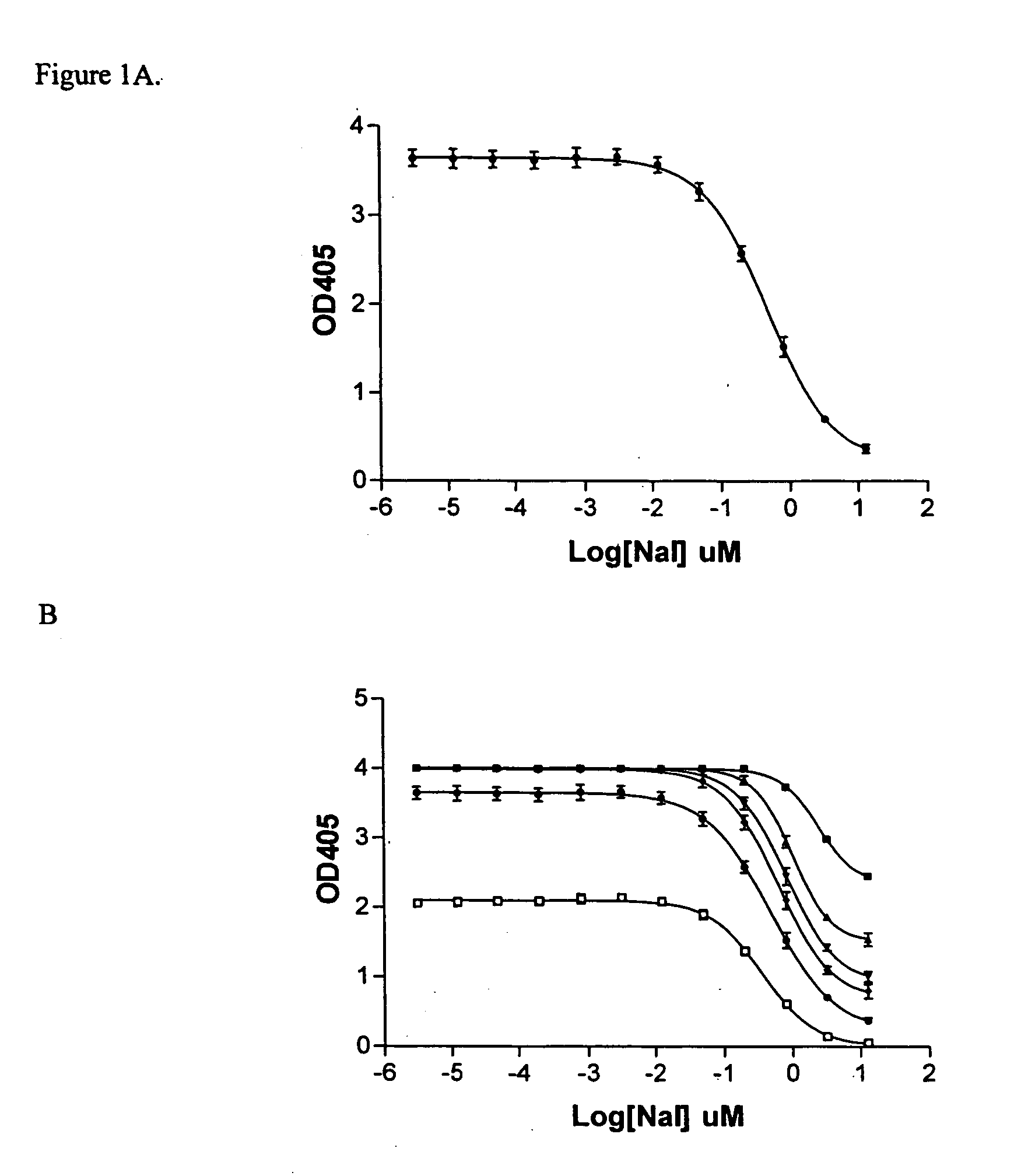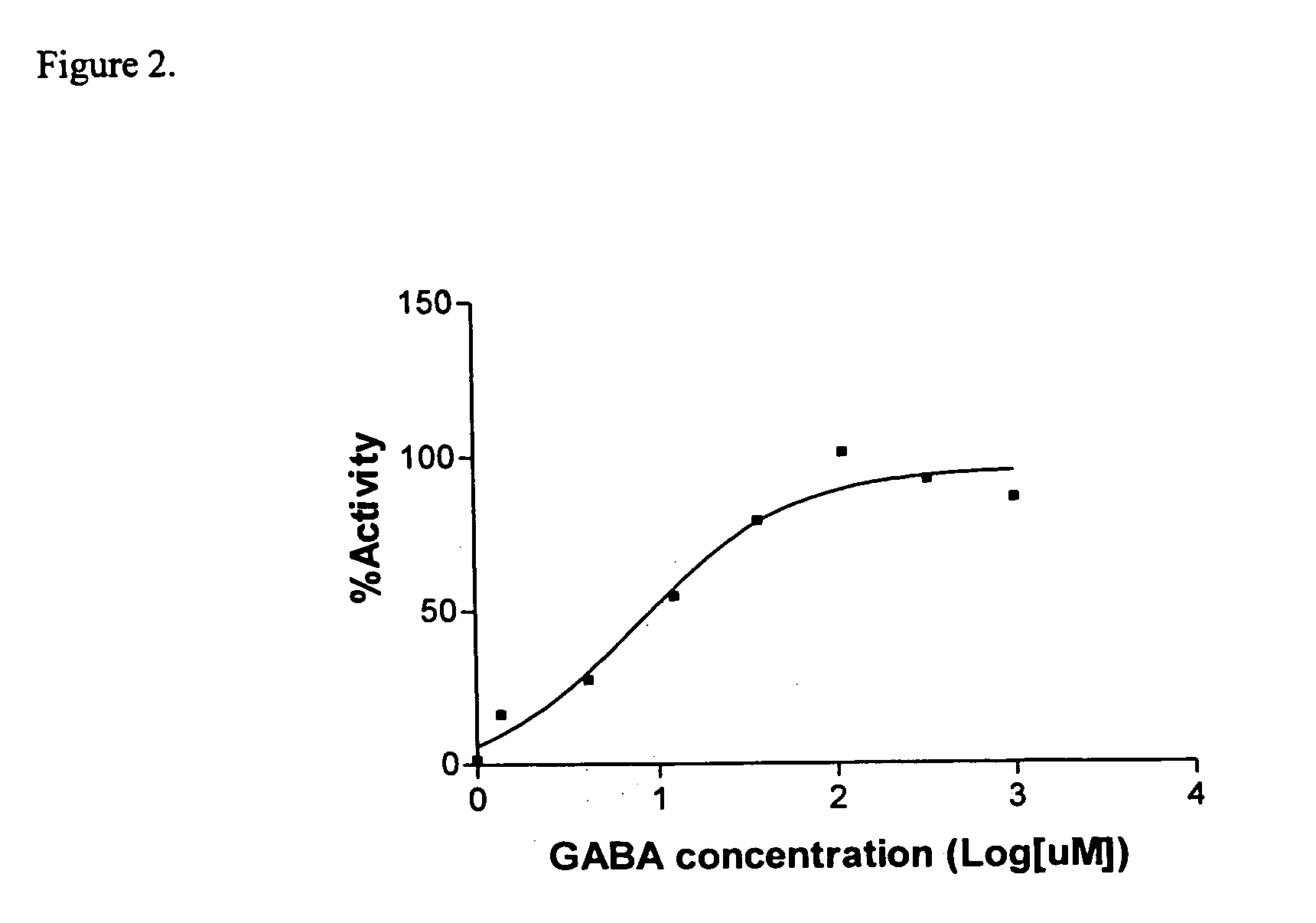Methods for measuring chloride channel conductivity
a technology of chloride channel and conductivity, which is applied in the field of colorimetric detection methods for assaying chloride channel conductivity, can solve the problems of difficult adaptation, low potency, and inability to readily find high affinity ligands for chloride channels, and achieves the effect of easy adaptation
- Summary
- Abstract
- Description
- Claims
- Application Information
AI Technical Summary
Benefits of technology
Problems solved by technology
Method used
Image
Examples
example 1
The Sandell-Kolthoff (SK) Assay on The Standard NaI Solutions
Materials
[0056] All chemicals were purchased from Sigma Aldrich Corp. (St Louis, Mo.) except otherwise indicated.
[0057] The following procedure was used to prepare the arsenic acid mixture: 1) 19.8 g of arsenic trioxide (As2O3) was dissolved in a solution consisting of 300 ml of purified water and 50 ml of ammonia hydroxide (25%); 2) 32 ml of sulfuric acid and 25 g of ammonium chloride (NH4Cl) were added to the solution; and 3) purified water was added to bring the final volume of the solution to 1000 ml.
[0058] The following procedure was used to prepare the ammonia-Ce(IV)-sulfate mixture: 1) 10 g of ammonia-Ce(IV)-sulfate ((NH4)4Ce(SO4)4.2H2O) was suspended in 400 ml purified water; 2) 26 ml of sulfuric acid was added to the solution to help dissolve the ammonia-Ce(IV)-sulfate; and 3) after the yellow salt was dissolved, purified water was added to bring the final volume of the solution to about 500 ml.
[0059] The st...
example 2
The Sandell-Kolthoff (SK) Assay on The Outwardly Rectifying GABAA Receptor
Materials
[0062] Similar chemicals and reagents as those described in Example 1 were used in this Example. In addition, the iodine loading buffer consisting of 150 mM NaI, 2 mM CaCl2, 0.8 mM NaH2PO4, 1 mM of MgCl2, and 5 mM of IK, 2% FBS (# 35-010-AV, CELLGRO, VA) pH7.4, was prepared by mixing and dissolving each described component into purified water, and adjusting the pH accordingly.
[0063] Cell line expressing human GABAA (Adenovirus type) was obtained from the American Type Culture Collection (ATCC, Cat No. CRL-2029). Cells were grown in supplemented DMEM medium consisting of DMEM medium (#10-017-CV, CELLGRO, VA), 4 mM L-glutamine, 1.5 g / L sodium bicarbonate, 4.5 g / L glucose, 1.0 mM sodium pyruvate, and 10% fetal bovine serum (# 35-010-AV, CELLGRO, VA)
Procedure
[0064] Cells in supplemented DMEM medium (200 μl, approx. 250,000 cells / ml) were added to each well of a D-lysine coated 96-well plate (Cornin...
example 3
The Sandell-Kolthoff (SK) Assay on The Outwardly Rectifying CFTR channel
Materials
[0068] Similar chemicals and reagents as those described in Example 2 were used in this Example.
[0069] HTB-79 cell line intrinsically expressing the human CFTR channel was obtained from ATCC. The CRL-1918 cell line, having a defective CFTR channel, was also obtained from ATCC. Cells were grown in Iscove's modified Dulbecco's medium consisting of Iscove's modified medium (CELLGRO, VA) and 4 mM L-glutamine, 1.5 g / L sodium bicarbonate, and 20% FBS (CELLGRO, VA).
Procedure
[0070] HTB-79 cells in Iscove's modified Dulbecco's medium (200 μl, approx. 500,000 cells / ml) were added to each well of a costar 96-well plate (Corning Costar, NY), and were incubated overnight in a tissue culture incubator at 37° C. under 90% air / 5% CO2. Then, the Iscove's modified Dulbecco's medium was removed and 200 μl of iodine-loading buffer was added to each well of the plate. Cells were incubated for 2-4 hours at 37° C. unde...
PUM
| Property | Measurement | Unit |
|---|---|---|
| a wavelength | aaaaa | aaaaa |
| wavelength | aaaaa | aaaaa |
| wavelength | aaaaa | aaaaa |
Abstract
Description
Claims
Application Information
 Login to View More
Login to View More - R&D
- Intellectual Property
- Life Sciences
- Materials
- Tech Scout
- Unparalleled Data Quality
- Higher Quality Content
- 60% Fewer Hallucinations
Browse by: Latest US Patents, China's latest patents, Technical Efficacy Thesaurus, Application Domain, Technology Topic, Popular Technical Reports.
© 2025 PatSnap. All rights reserved.Legal|Privacy policy|Modern Slavery Act Transparency Statement|Sitemap|About US| Contact US: help@patsnap.com



